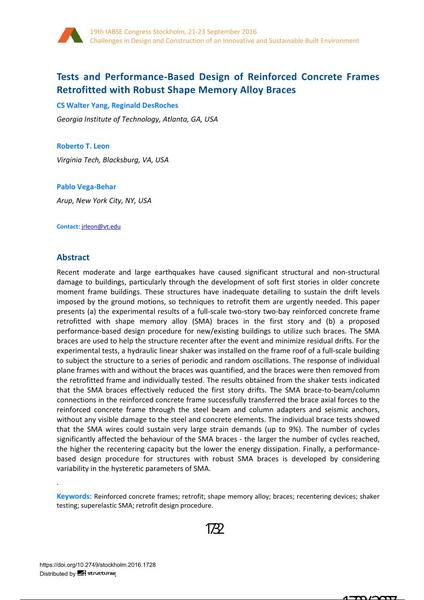Tests and Performance-Based Design of Reinforced Concrete Frames Retrofitted with Robust Shape Memory Alloy Braces

|
|
|||||||||||
Détails bibliographiques
| Auteur(s): |
C. S. Walter Yang
(Georgia Institute of Technology, Atlanta, GA, USA)
Reginald DesRoches (Georgia Institute of Technology, Atlanta, GA, USA) Roberto T. leon (Virginia Tech, Blacksburg, VA, USA) Pablo Vega-Behar (Arup, New York City, NY, USA) |
||||
|---|---|---|---|---|---|
| Médium: | papier de conférence | ||||
| Langue(s): | anglais | ||||
| Conférence: | IABSE Congress: Challenges in Design and Construction of an Innovative and Sustainable Built Environment, Stockholm, Sweden, 21-23 September 2016 | ||||
| Publié dans: | IABSE Congress Stockholm, 2016 | ||||
|
|||||
| Page(s): | 1732-1739 | ||||
| Nombre total de pages (du PDF): | 8 | ||||
| Année: | 2016 | ||||
| DOI: | 10.2749/stockholm.2016.1728 | ||||
| Abstrait: |
Recent moderate and large earthquakes have caused significant structural and non-structural damage to buildings, particularly through the development of soft first stories in older concrete moment frame buildings. These structures have inadequate detailing to sustain the drift levels imposed by the ground motions, so techniques to retrofit them are urgently needed. This paper presents (a) the experimental results of a full-scale two-story two-bay reinforced concrete frame retrofitted with shape memory alloy (SMA) braces in the first story and (b) a proposed performance-based design procedure for new/existing buildings to utilize such braces. The SMA braces are used to help the structure recenter after the event and minimize residual drifts. For the experimental tests, a hydraulic linear shaker was installed on the frame roof of a full-scale building to subject the structure to a series of periodic and random oscillations. The response of individual plane frames with and without the braces was quantified, and the braces were then removed from the retrofitted frame and individually tested. The results obtained from the shaker tests indicated that the SMA braces effectively reduced the first story drifts. The SMA brace-to-beam/column connections in the reinforced concrete frame successfully transferred the brace axial forces to the reinforced concrete frame through the steel beam and column adapters and seismic anchors, without any visible damage to the steel and concrete elements. The individual brace tests showed that the SMA wires could sustain very large strain demands (up to 9%). The number of cycles significantly affected the behaviour of the SMA braces - the larger the number of cycles reached, the higher the recentering capacity but the lower the energy dissipation. Finally, a performance- based design procedure for structures with robust SMA braces is developed by considering variability in the hysteretic parameters of SMA. . |
||||
| Mots-clé: |
retrofit
|
||||

